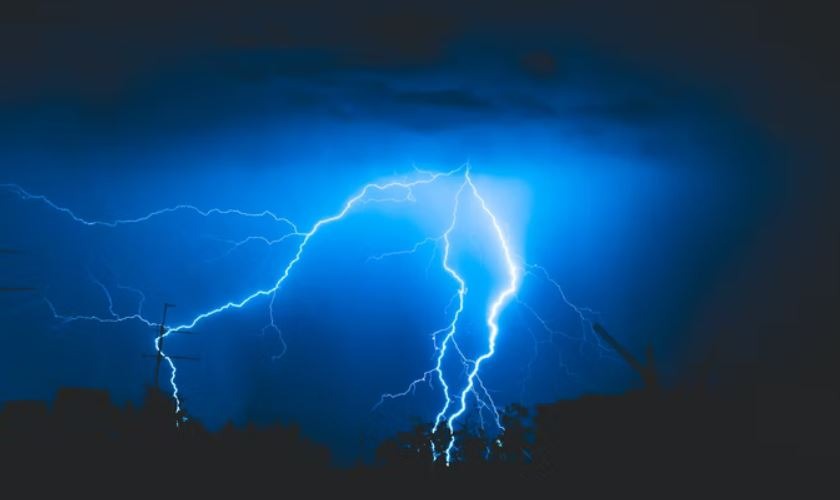How to Stay Safe During a Lightning Storm
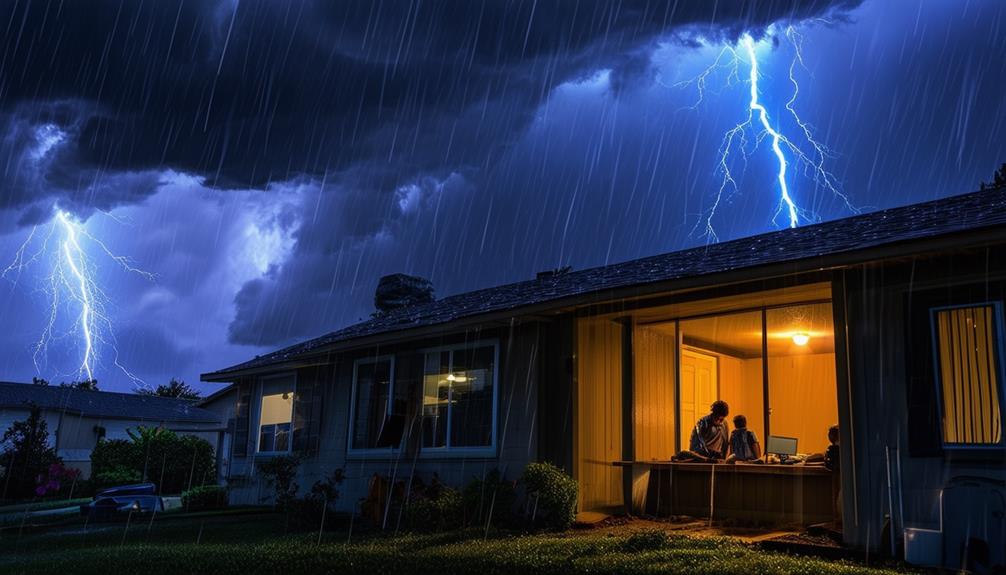
When a lightning storm hits, your priority should be finding a safe place to wait it out. Contrary to common belief, staying under a tree or inside a car is not always safe. Specific precautions are necessary to avoid injury. Following the right steps can make a significant difference between safety and danger. Do you know what to avoid indoors or how long you should wait before stepping outside again? Let's explore the best practices to keep you and your loved ones safe until the storm passes.
Understanding Lightning Risks
Lightning can strike up to 10 miles away from a storm, even when skies appear clear. This means you could be at risk without seeing dark clouds or hearing thunder. Recognizing that lightning is unpredictable and can strike any object dispels the myth that certain items are immune.
The safest course of action is to seek secure shelter immediately. Being indoors offers the best protection from direct and indirect strikes. Tents and pavilions don't provide adequate shelter from lightning. If you're caught outside, find a fully enclosed building or a metal-topped vehicle to minimize the risk.
Bodies of water amplify the lightning threat due to their conductivity, making activities like swimming or boating during a thunderstorm extremely dangerous. Follow these safety tips: when you hear thunder, go indoors immediately and stay there until the storm passes. The risk of being struck by lightning decreases significantly when you take these precautions seriously.
Recognizing Lightning Warning Signs
If you hear thunder, it means lightning is close enough to pose a threat, so seek shelter immediately. To estimate the distance of the storm, count the seconds between seeing the lightning and hearing the thunder, then divide this number by five to approximate the distance in miles.
Signs of Imminent Lightning
When dark clouds gather and distant thunder rumbles, these are early indications of an imminent lightning storm. A sudden temperature drop and rapid wind changes also signal an approaching storm. Be observant of the sky and the air; static electricity can cause the hair on your arms or neck to stand up, indicating an increased risk of lightning strikes.
Additional warning signs include a blue haze or crackling sounds, both suggesting that lightning is imminent. Animals often sense danger before humans. If you observe birds flying low, pets becoming agitated, or wildlife seeking shelter, take these behaviors seriously as they can precede a storm.
Recognizing these signs promptly gives you time to find a safe place to wait out the storm. Don't ignore these natural warnings—your safety relies on being aware and prepared. Understanding these indicators allows you to better protect yourself and those around you during a lightning storm.
Thunder as Lightning Indicator
Hearing thunder means lightning is close enough to strike, so seek immediate shelter. Thunder acts as a crucial warning sign indicating the proximity of lightning. When you hear thunder, it means lightning is close enough to pose a serious safety risk. Don't wait—immediately move to a safe location like a building or a car.
Recognizing thunder as a lightning indicator is vital for your safety. Lightning can strike up to 10 miles away from a thunderstorm, so even if the storm seems distant, you're still at risk. Thunder serves as a clear indicator that you should be on high alert and seek shelter without delay.
Here's a visual guide to understanding thunder as a lightning warning sign:
| Thunder | Action |
|---|---|
| Heard | Seek immediate shelter |
| Not heard | Stay alert, but evaluate surroundings |
| Continuous | Remain in shelter until it passes |
Remember, waiting for thunder after seeing lightning helps you gauge the storm's proximity. This practice is essential for evaluating potential lightning risk and ensuring your safety. Always use thunder as your cue to find shelter and stay protected from lightning strikes. Understanding these warning signs can significantly reduce your risk and keep you safe during a lightning storm.
Distance Calculation Method
To determine the distance of lightning, count the seconds between the flash and the subsequent thunder, then divide that number by 5. This calculation gives the distance in miles. Hearing thunder indicates the potential for a nearby lightning strike, so seek shelter immediately, as lightning can strike up to 10 miles from its source.
Do not rely on myths such as rubber soles or tires providing protection from lightning. Lightning is unpredictable and can strike any object, regardless of its composition. Adhering to safety guidelines is essential to minimize the risk of being struck. If you hear thunder, act promptly. Seek shelter in a sturdy building or a hard-topped vehicle. Avoid open fields, tall trees, and bodies of water, as these are particularly hazardous during a storm.
Seeking Safe Shelter
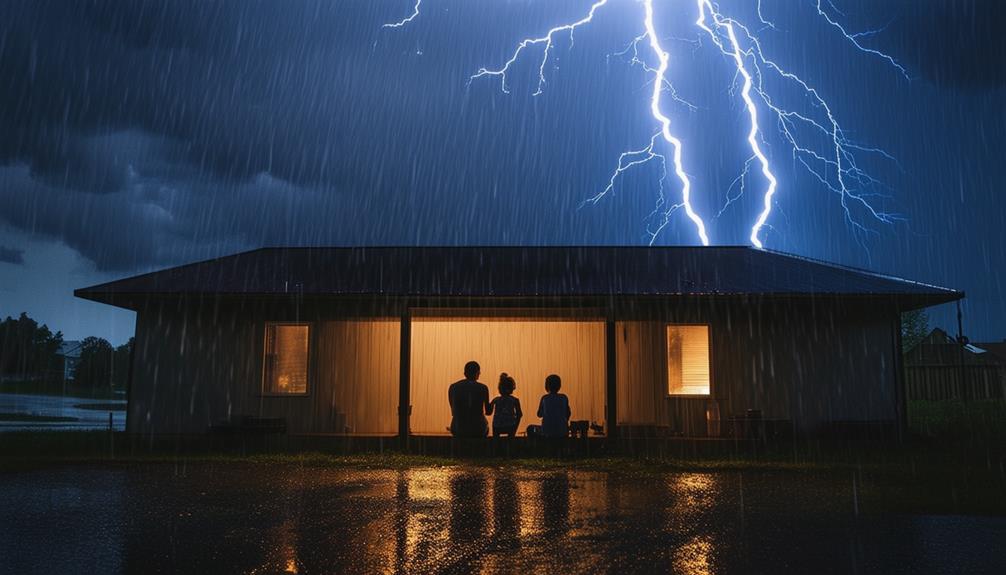
When you hear thunder, seek shelter in a sturdy building with wiring and plumbing, as these structures offer the best protection. Avoid open spaces, isolated trees, and metal structures, as they attract lightning. Stay indoors for at least 30 minutes after the last thunderclap to ensure your safety.
Indoors Safety Tips
During a lightning storm, seek shelter in a sturdy building equipped with plumbing and wiring for optimal protection. Follow these indoor safety tips to minimize risks:
- Avoid using corded phones and electrical appliances: Lightning can travel through wiring and electrical systems, putting you at risk.
- Stay away from plumbing fixtures: Sinks, faucets, and other plumbing fixtures can conduct electricity, so avoid contact with these surfaces.
- Keep off porches and away from windows and doors: These areas can expose you to lightning strikes. Stay in the interior parts of the building.
- Minimize contact with conductive surfaces: Concrete floors and walls can act as lightning conductors. Avoid touching these surfaces during a storm.
Staying inside a sturdy building with these safety measures can significantly reduce your risk of lightning-related injuries. The key is to minimize exposure to conductive surfaces and avoid activities that increase the likelihood of a lightning strike.
Avoiding Unsafe Structures
Choosing the right shelter during a lightning storm is crucial for your safety. Seek refuge in large enclosed structures with plumbing and wiring, as these buildings offer the best protection by channeling electricity safely into the ground. Avoid unsafe structures such as sheds, pavilions, or any buildings with exposed openings, as they leave you vulnerable to lightning strikes.
Similarly, steer clear of open cab vehicles like golf carts and convertibles, which don't provide adequate protection. If a large building is unavailable, an enclosed metal vehicle is a decent alternative. The metal frame can help direct the lightning around you and into the ground, reducing your risk of injury.
Indoor Lightning Safety
Did you know that staying indoors during a lightning storm doesn't always guarantee safety? Certain precautions are crucial to minimize risks.
- First, avoid plumbing fixtures like sinks and faucets, as they can conduct electricity. This means not using water until the storm has passed.
- Second, avoid cement floors and walls. Cement can conduct electricity from a lightning strike, posing a risk.
- Third, stay away from metal objects and appliances, including metal doors, windows, and indoor bicycles.
- Finally, avoid using electrical devices and corded phones. Unplugging devices can prevent electrical surges, and using a corded phone can expose you directly to a lightning strike.
Here's a quick checklist for indoor lightning safety:
- Avoid plumbing fixtures.
- Avoid cement floors and walls.
- Steer clear of metal objects and appliances.
- Refrain from using electrical devices and corded phones.
Outdoor Risk Reduction
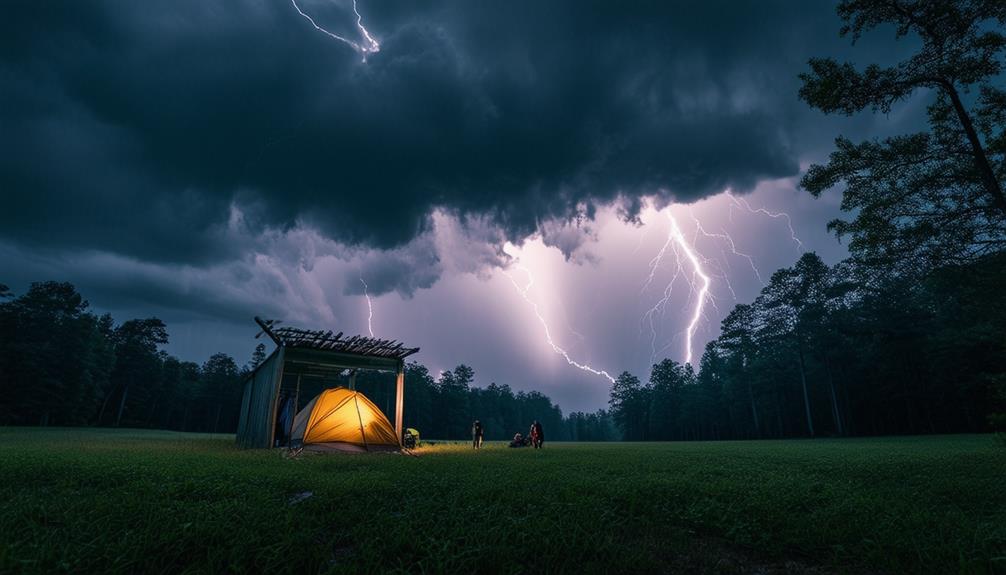
When you're caught outdoors during a lightning storm, your initial priority should be to seek shelter in a sturdy building or an enclosed vehicle. This action can significantly reduce the risk of lightning strikes. If you can't reach shelter quickly, avoid isolated trees, rocky overhangs, and bodies of water, as these areas are prone to lightning strikes.
If you find yourself in an open area, minimize your risk by crouching low to the ground on the balls of your feet, keeping as little of your body in contact with the ground as possible. This position reduces your height and makes you a less likely target for lightning.
Here's a quick reference table to help you remember these tips:
| Situation | Action to Take |
|---|---|
| Open Area | Crouch low to the ground on balls of feet |
| Near Isolated Tree | Move away and find lower ground |
| Near Sturdy Building | Seek immediate shelter inside |
Always stay away from objects that conduct electricity, such as metal fences or power lines. Lightning can strike up to 10 miles away from a storm, so take immediate action when you hear thunder. Prioritizing these steps during an outdoor activity can greatly improve your safety.
Safety in Vehicles
To stay safe during a lightning storm, seek shelter inside an enclosed vehicle with a metal roof and sides. These vehicles provide better protection against lightning strikes compared to being outdoors. The metal frame helps disperse the electrical charge, reducing the risk of injury.
Follow these steps for enhanced safety:
- Remain inside the vehicle: Keep all windows closed to prevent contact with the outside environment.
- Avoid touching metal surfaces: Since metal conducts electricity, don't touch door handles, gear shifts, or other metallic parts inside the vehicle.
- Do not rely on rubber tires: Contrary to popular belief, rubber tires don't shield vehicles from lightning. It's the metal roof and frame that provide safety.
- Select the right vehicle: Convertible cars, golf carts, and open cab vehicles are unsafe during lightning storms. Only enclosed vehicles with metal roofs and sides are effective.
If a secure building isn't available, your vehicle is the next best option. Following these guidelines can significantly reduce the risk of injury during a thunderstorm. Remember, staying inside a vehicle with a metal roof and sides is crucial for your safety.
Protecting Pets

Just as you take steps to protect yourself during a lightning storm, it's equally important to ensure your pets are safe from potential lightning-related injuries. Pet safety should be a priority when a thunderstorm rolls in.
One of the most effective injury prevention measures is to replace metal accessories with plastic ones. Metal collars, leashes, and harnesses can conduct electricity during a lightning strike, posing a significant risk to your pets.
To reduce this risk, remove any metal accessories from your pets and use plastic alternatives instead. This simple change can greatly enhance their safety during a storm. Keep your pets indoors as much as possible during thunderstorms, and avoid leaving them outside where they're more vulnerable to lightning strikes.
By taking these precautions, you actively safeguard your pets from potential harm. Remember, your pets depend on you for their safety, so these actions not only reduce the risk of injury but also help keep them calm and secure during the storm. Prioritizing pet safety can prevent unnecessary injuries and ensure the well-being of your furry friends.
Emergency Response Tips
In a lightning-related emergency, call 911 immediately to ensure timely assistance. Providing accurate location details is crucial for emergency responders to reach you quickly. Assess the situation for any safety risks before taking any action.
If someone is struck by lightning, follow these steps for an effective emergency response:
- Call 911: Report the incident and provide your exact location. Time is critical, and faster notification helps responders reach you quicker.
- Check for Safety Risks: Make sure the area is safe from ongoing lightning or other hazards before approaching the victim.
- Assess the Victim's Condition: Check for breathing and pulse to determine if resuscitation measures like CPR are necessary.
- Administer CPR: If the person isn't breathing or has no pulse, start CPR immediately. This involves giving rescue breaths and chest compressions until professional help arrives.
Staying calm and focused can make a significant difference in such emergencies. Understanding these emergency response steps will help you act effectively, reducing risks and potentially saving a life during a lightning storm.
First Aid for Lightning Strikes
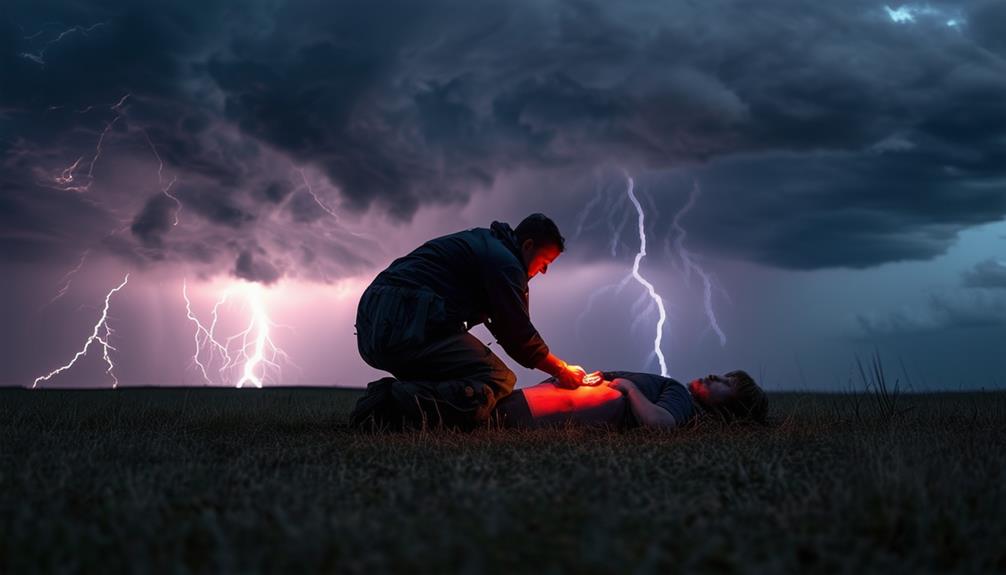
When someone is struck by lightning, immediate action is crucial for their survival. Start by calling 911 to ensure prompt medical assistance. While waiting for emergency responders, check the victim's breathing and pulse. If they aren't breathing or lack a pulse, begin CPR immediately, which includes chest compressions and rescue breaths to maintain circulation and oxygen flow.
While performing CPR, protect the victim from cold and wet conditions using available materials such as clothing or blankets to keep them warm and dry, as hypothermia can worsen their condition. Stay with the victim and continue resuscitation efforts until professional help arrives. Your swift and calm actions can significantly improve their chances of recovery.
Conclusion
To stay safe during a lightning storm, it's essential to act quickly and make informed decisions. Recognize the warning signs and immediately seek shelter indoors. Once inside, avoid using corded phones, electrical devices, windows, and plumbing fixtures. If you're caught outside, find a low-lying area away from trees and metal structures. By taking these precautions and acting swiftly, you can significantly reduce your risk of harm during a lightning storm. Stay vigilant and prioritize your safety.


